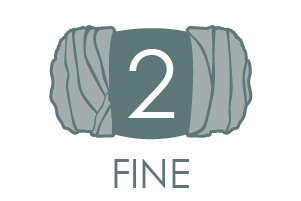
Arley is the perfect beginner cardigan for granny stitch lovers. Once you have acquired your basic granny skills, it’s time to scale-up to this beauty. Two hexagons folded and seamed together, worked in a very simple pattern, with the only challenge of an easy sleeve shape.
Time: 20-30 Hours pattern
Skill Level: Easy
Size: Finished bust size 33 (37, 41, 45, 49)” to fit bust size 32 (36, 40, 44, 48)”.
0-1“ positive ease recommended.
Shown in finished bust size 37.
Gauge: 13 sts and 13 rows = 4″ [10cm] worked in pattern after blocking.
Materials
 Yarn: KATIA Fair cotton (100% Cotton; 170 yards [155 meters]/50 grams); colors: 11 pearl light grey (MC 4 (4, 5, 5, 6) balls), 36 khaki (CC1 1 (1, 1, 2, 2) balls), 37 mustard (CC2 1 (1, 1, 2, 2) balls), 38 green blue (CC3 1 (1, 1, 2, 2) balls).
Yarn: KATIA Fair cotton (100% Cotton; 170 yards [155 meters]/50 grams); colors: 11 pearl light grey (MC 4 (4, 5, 5, 6) balls), 36 khaki (CC1 1 (1, 1, 2, 2) balls), 37 mustard (CC2 1 (1, 1, 2, 2) balls), 38 green blue (CC3 1 (1, 1, 2, 2) balls).
Hook: US size E-4 (3.5 mm).
Notions: Tapestry needle. Split ring or locking st marker.
Downloads:
Pattern Notes
The construction of this trendy cropped cardigan is easier that it appears. It is made from two basic hexagons that are folded and seamed at the back and arms.
Sleeves are shaped by adding some decreases at the middle of the first side (described in the pattern at the beginning of each round and also displayed in Stitch Diagram 1). I recommend to use a stitch marker to mark where you need to apply this decrease across the round. Stitch marker is to be moved up in each round to mark the stitches where decreases are to be made.
The 3 dc worked into the same chain-space are referred to as a cluster.
Ch 3 at the beginning of the round counts as a dc.
Pattern
Hexagons (make 2)
Body
With MC, ch 6, sl st to first ch to join.
Rnd 1: Ch 3 (counts as dc here and throughout), 2 dc in ring, ch 3, *3 dc in ring, ch 3; rep from * 4 more times, sl st on top of first st, 2 sl st in each of the next 2 dc. (6 clusters)
Rnd 2: *[sc, ch 3, sc] in next ch-3 sp, ch 3; rep from * 5 more times, sl st on top of first st, sl st in next ch-3 sp. (12 sc)
Rnd 3: [ch 3, 2 dc, ch 3, 3 dc] in ch-3 corner sp, ch 1, 1 dc in next ch-3 sp, PM (this st will be the center of the sleeve decreases), ch 1, *[3 dc, ch 3, 3 dc] in ch-3 corner sp, ch 1, 3 dc in next ch-3 sp, ch 1; rep from * 4 more times, sl st on top of first st, 2 sl st in each of the next 2 dc. (17 clusters)
Rnd 4: [sc, ch 3, sc] in next ch-3 corner sp, [ch 3, sc] in each of the next ch-1 sp until M, ch 1, sc in next ch-1 sp, ch 3, *[sc, ch 3, sc] in next ch-3 corner sp, ch 3, [sc, ch 3] in each of next ch-1 sp until corner sp; rep from * 4 more times, sl st on top of first st, sl st in next ch-3 corner sp. (24 sc)
Rnd 5: [ch 3, 2 dc, ch 3, 3 dc] in ch-3 corner sp, ch 1, [3 dc, ch 1] in each of the next ch-3 sp to corner, *[3 dc, ch 3, 3 dc] in ch-3 corner sp, ch 1, [3 dc, ch 1] in each of the next ch-3 sp to corner; rep from * 4 more times, sl st on top of first st, 2 sl st in each of the next 2 dc. (29 clusters)
Rnd 6: *[sc, ch 3, sc] in next ch-3 corner sp, ch 3, [sc, ch 3] in each of the next ch-1 sp; rep from * 5 more times, sl st on top of first st, sl st in next ch-3 corner sp. (35 sc)
Rnd 7: [ch 3, 2 dc, ch 3, 3 dc] in ch-3 corner sp, ch 1, [3 dc, ch 1] in each of the next ch-3 sp until ch-3 previous to M, 1 dc in each of the next 2 ch-3 sps, ch 1, [3 dc, ch 1] in each of the next ch-3 sp before corner, *[3 dc, ch 3, 3 dc] in ch-3 corner sp, ch 1, [3 dc, ch 1] in each of the next ch-3 sp before corner; rep from * 4 more times, sl st on top of first st, 2 sl st in each of the next 2 dc. (39 clusters)
Rnd 8: [sc, ch 3, sc] in next ch-3 corner sp, [ch 3, sc] in each of the next ch-1 sp until M, ch 1, sc in next ch-1 sp, ch 3, [sc, ch 3] in each of the next ch-1 sp, *[sc, ch 3, sc] in next ch-3 sp, ch 3, [sc, ch 3] in each of the in next ch-1 sp to corner ch-3 sp; rep from * 4 more times, sl st on top of first st, sl st in next ch-3 corner sp. (46 sc)
Rep Rnds 5-8 another 3 (4, 5, 6, 7) more times. (112 (134, 156, 178, 200) sc)
Border
Rnd 1: With CC1, as Rnd 6 (Body). (117 (139, 161, 183, 205) clusters)
Rnd 2: With MC, as Rnd 7 (Body). (123 (145, 167, 189, 211) sc)
Rnd 3: With CC2, as Rnd 8 (Body). (127 (149, 171, 193, 215) clusters)
Rnd 4: With MC, as Rnd 5 (Body). (134 (156, 178, 200, 222) sc)
Rnd 5: With CC3, as Rnd 6 (Body). (139 (161, 183, 205, 227) clusters)
Rnd 6: with CC3, *3 sc in ch-3 corner sp, skip ch-1, sc in each of the next dc; rep from * 5 more times; sl st on top of first st.
Assembly
Fold the hexagons as shown in Figure 1 and then seam them with a whipstitch across the back and top sleeves.
Finishing
Weave in all ends.
Blocking/ironing is optional, but I recommend it for a better finishing.



Abbreviation “M” is used, is this referring to where the stitch holder is placed? PM is mentioned in the notes, but no M. It would be helpful to have all abbreviations used to be part of the written instructions.
Thanks just too cute for spring
Hi Tammy! I am glad you like it and I hope to see it finished! Your are right. there is a typo and it should be “round 5” instead of “round 9”. Thanks for pointing this out. I believe Nicola will correct it asap :=).
This is lovely! I wonder if some of the instructions are missing though? For the border, Round 4 of the border says work with MC as Round 9, but there is no Round 9 in the main instructions. Thank you!
Hello Tammy! I’ve reached out to the designer for advice and she or I will reply as soon as possible. Thanks! – Nicola, Editor
Thanks so much!